
Agrotis ipsilon, the dark sword-grass, black cutworm, greasy cutworm, floodplain cutworm or ipsilon dart, is a small noctuid moth found worldwide. The moth gets its scientific name from black markings on its forewings shaped like the letter "Y" or the Greek letter upsilon. The larvae are known as "cutworms" because they cut plants and other crops. The larvae are serious agricultural pests and feed on nearly all varieties of vegetables and many important grains.
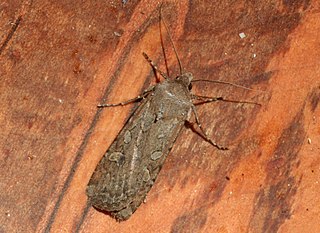
The army cutworm is the immature form of Euxoa auxiliaris. The adult moth is called a "miller moth" because of the fine scales on its wings that rub off easily and remind people of the dusty flour that covers the clothing of a miller.
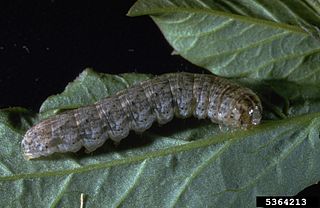
Euxoa messoria, the darksided cutworm or reaper dart, is a moth of the family Noctuidae. The species was first described by Thaddeus William Harris in 1841. It is found from Newfoundland west to Yukon, south to Virginia and Missouri in the east and New Mexico, Arizona and California in the west.

Abagrotis alternata, the greater red dart or mottled gray cutworm, is a moth of the family Noctuidae. The species was first described by Augustus Radcliffe Grote in 1865. It is found in eastern North America, from New Brunswick west across southern Canada to western Alberta, south to Arizona, New Mexico and the Gulf of Mexico.
Abagrotis brunneipennis, the Yankee dart, is a moth of the family Noctuidae. The species was first described by Augustus Radcliffe Grote in 1875. It is found in North America from Newfoundland west to Vancouver Island, south to west central Oregon, Utah, Colorado and North Carolina.
Abagrotis orbis, the well-marked cutworm or Barnes' climbing cutworm, is a moth of the family Noctuidae. The species was first described by Augustus Radcliffe Grote in 1876. It is in southwestern North America, extending eastward across the plains and with a large disjunct population in dune habitats in the southern Great Lakes area. It extends into western Canada only in the southern interior of British Columbia and southern Alberta and Saskatchewan.

Agrotis vetusta, the old man dart, spotted-legged cutworm or muted dart is a moth of the family Noctuidae. The species was first described by Francis Walker in 1865. It is found in North America, from southern Alaska to Nova Scotia, southward into Mexico.

Agrotis venerabilis, the dusky cutworm, is a moth of the family Noctuidae. The species was first described by Francis Walker in 1857. It is found from coast to coast from central Canada south to Mexico.

Euxoa catenula is a species of moth of the family Noctuidae first described by Augustus Radcliffe Grote in 1879. It is found in North America from southern Saskatchewan west to southern Vancouver Island, south to Kansas, New Mexico, Arizona and southern California.

Euxoa mimallonis is a species of moth of the family Noctuidae first described by Smith in 1890. It is found in North America from Nova Scotia west to coastal British Columbia, south in the east to Michigan and Minnesota, in the west to central California and New Mexico.
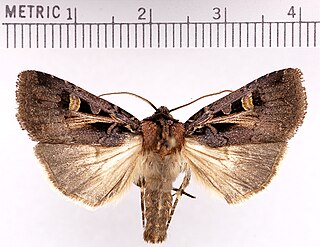
Feltia herilis, the herald dart or Master's dart, is a moth of the family Noctuidae. The species was first described by Augustus Radcliffe Grote in 1873. It is found in North America from Vancouver Island to Newfoundland, north to the Northwest Territories border and south to the Gulf Coast.
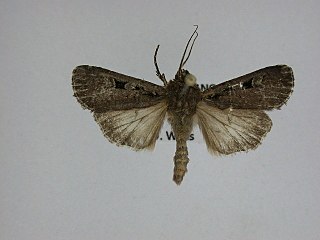
Euxoa tessellata, the tessellate dart or striped cutworm is a moth of the family Noctuidae. It is the most widespread Euxoa-species in North America. It is found from Newfoundland to Alaska, south in the west to California, Arizona, New Mexico, south in the east to Florida. It seems to be absent from Texas and adjacent eastern states.

Protolampra brunneicollis, the brown-collared dart, is a moth of the family Noctuidae. The species was first described by Augustus Radcliffe Grote in 1864. It is found in eastern North America from New Brunswick to Alberta in southern Canada, and in the United States from Maine to North Carolina and Tennessee west to Mississippi, north to Minnesota, with scattered records in the west from North Dakota, South Dakota and Montana.

Euxoa adumbrata, the sordid dart, is a moth of the family Noctuidae. The species was first described by Eduard Friedrich Eversmann in 1842. In North America it is found across northern Canada from Quebec to western Alaska, south to the northern parts of the United States, and in the mountains to Colorado. It is also found in Greenland, the coastal areas of Scandinavia and the Ural. It was recently recorded from Denmark, although this includes Euxoa lidia, which some authors regard to be a valid species.
Euxoa declarata, the clear dart, is a moth of the family Noctuidae. The species was first described by Francis Walker in 1865. It is found in Canada in Ontario, Quebec, New Brunswick, Nova Scotia, Prince Edward Island, British Columbia, Alberta, Saskatchewan, Yukon and Manitoba. It is found as far west as central Alaska. In the United States it is also found to Minnesota and North Carolina in the east and Arizona, New Mexico and California in the west.
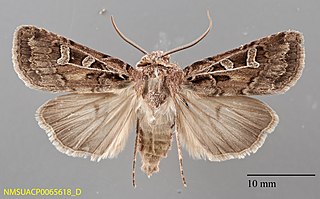
Euxoa divergens, the divergent dart, is a moth of the family Noctuidae. The species was first described by Francis Walker in 1857. It is found in North America from Newfoundland to Alaska, south to New York and Michigan in the east, and in the mountains of the west, south to New Mexico, Arizona and California.
Euxoa auripennis is a moth of the family Noctuidae first described by J. Donald Lafontaine in 1974. It is found in western North America from eastern North Dakota and south-western Manitoba west to central British Columbia, south to southern California and Colorado.
Euxoa aurulenta, the dune cutworm, is a moth of the family Noctuidae. The species was first described by Smith in 1888. It is found in North America from Ontario west to Alberta and Washington, south to Illinois, Nebraska, Colorado and Arizona.
Euxoa comosa, the hairy euxoa moth, is a moth of the family Noctuidae first described by Herbert Knowles Morrison in 1876. It is found in western North America, except the Pacific coast, ranging east through the northern Great Plains, and in the Hudsonian zone to the Atlantic Ocean. It is found in every province and territory of Canada, except Nunavut.
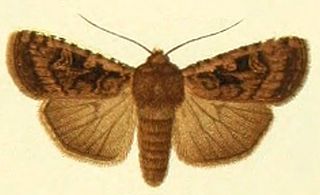
Euxoa ochrogaster, the red-backed cutworm, is a moth of the family Noctuidae. It is found from Iceland and northern Europe, through the Baltic to the Amur region. In North America, it is found from Alaska to Newfoundland and Labrador, south into the northern part of the United States, south in Rocky Mountains to Arizona and New Mexico.













